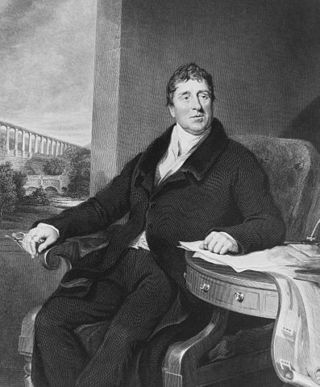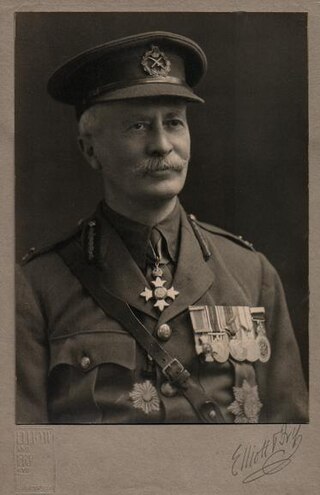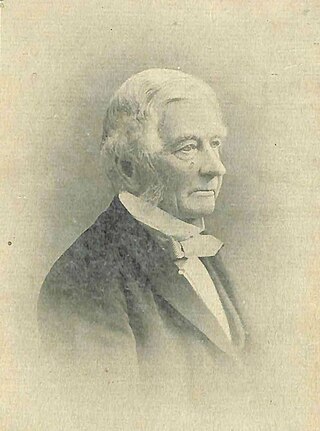
Thomas Telford was a Scottish civil engineer. After establishing himself as an engineer of road and canal projects in Shropshire, he designed numerous infrastructure projects in his native Scotland, as well as harbours and tunnels. Such was his reputation as a prolific designer of highways and related bridges, he was dubbed the Colossus of Roads, and, reflecting his command of all types of civil engineering in the early 19th century, he was elected as the first president of the Institution of Civil Engineers, a post he held for 14 years until his death.

King's Cross railway station, also known as London King's Cross, is a passenger railway terminus in the London Borough of Camden, on the edge of Central London. It is in the London station group, one of the busiest stations in the United Kingdom and the southern terminus of the East Coast Main Line to Yorkshire and the Humber, North East England and Scotland. Adjacent to King's Cross station is St Pancras International, the London terminus for Eurostar services to continental Europe. Beneath both main line stations is King's Cross St Pancras tube station on the London Underground; combined, they form one of the country's largest and busiest transport hubs.
Colonel William George Cubitt, was a senior officer in the British Indian Army and a recipient of the Victoria Cross, the highest award for gallantry in the face of the enemy that can be awarded to British and Commonwealth forces.

John Rickman was an English government official and statistician of the early nineteenth century.

Huntingtower Castle, once known as Ruthven Castle or the Place of Ruthven, is located near the village of Huntingtower beside the A85 and near the A9, about 5 km NW of the centre of Perth, Perth and Kinross, in central Scotland, on the main road to Crieff. This castle is the subject for several local ghostlore stories.

Howrah railway station is a railway station located in the city of Howrah, West Bengal, India. It is the largest and busiest railway complex in India as well as one of the busiest and largest train stations in the world. It is also the oldest surviving railway station complex in India. Howrah is one of six intercity train stations serving the Kolkata metropolitan area, the others being Sealdah, Dankuni, Santragachi, Shalimar and Kolkata railway station.

Huntingtower and Ruthvenfield is a village in Perthshire, Scotland, on the River Almond, 3 miles northwest of Perth.

Sir William Cubitt FRS was an English civil engineer and millwright. Born in Norfolk, England, he was employed in many of the great engineering undertakings of his time. He invented a type of windmill sail and the prison treadwheel, and was employed as chief engineer, at Ransomes of Ipswich, before moving to London. He worked on canals, docks, and railways, including the South Eastern Railway and the Great Northern Railway. He was the chief engineer of Crystal Palace erected at Hyde Park in 1851.

Abbots Langley is a large village and civil parish in the English county of Hertfordshire. It is an old settlement and is mentioned in the Domesday Book. Economically the village is closely linked to Watford and was formerly part of the Watford Rural District. Since 1974 it has been included in the Three Rivers district.
Luncarty is a village in Perth and Kinross, Scotland, approximately 4 miles north of Perth. It lies between the A9 to the west, and the River Tay to the east.

James Abernethy FRSE MICE was a Scottish civil engineer.

The East Indian Railway Company, operating as the East Indian Railway, introduced railways to East India and North India, while the Companies such as the Great Indian Peninsula Railway, South Indian Railway, Bombay, Baroda and Central India Railway and the North-Western Railway operated in other parts of India. The company was established on 1 June 1845 in London by a deed of settlement with a capital of £4,000,000, largely raised in London.

Sir Maurice Fitzmaurice CMG was an Irish civil engineer. He was apprenticed to Benjamin Baker and worked with him on the Forth Railway Bridge before going to Egypt to build the Aswan Dam for which he was appointed both a member of the Ottoman Order of the Mejidiye and a companion of the British Order of St Michael and St George. Following this Fitzmaurice was Chief Engineer to the London County Council and was responsible for the Blackwall, Rotherhithe and Woolwich tunnels. In later life his consultancy advised on docks and harbours across the British Commonwealth as well as the Sennar Dam in Sudan and he was recognised with the prestigious honour of the presidency of the Institution of Civil Engineers for the 1916-17 session.

Koilwar Bridge, at Koilwar in Bhojpur spans the Sone river. This 1.44 km long, 2-lane, rail-cum-road bridge connects the city of Arrah with Patna, the capital of Bihar state in India. The bridge is named after Indian academic and social reformer Prof. Abdul Bari, and is presently the oldest operational railway bridge in India, standing since 4 November 1862. It is shown in the 1982 Oscar award winning film Gandhi, directed by Richard Attenborough. From 1862 to 1900, Koilwar Bridge remained as the longest river bridge in India.

Brigadier-General William Thomas Clifford Beckett CBE DSO VD was a British railway engineer in India and a British Army officer.

Hector Turnbull was a leading Perthshire linen bleachfield developer and operator.

Folkestone Harbour is the main harbour of the town of Folkestone in Kent, England.

Sir Rowland Macdonald Stephenson was a 19th-century British railway engineer instrumental in the establishment of the East India Railway in British India.
George Heald was a civil engineer active at the beginning of the 19th century, notable for his role in the building of railways that formed part of the Grand Junction Railway, the Lancaster and Carlisle Railway, the Caledonian Railway and the North Midland Railway. Nowadays he is largely forgotten but to his contemporaries and those that followed immediately afterwards, he was one of the key engineers of the early railway age being listed alongside Brunel, Stephenson, Locke and Cubitt in George Drysdale Dempsey's book, the Practical Railway Engineer. He was a colleague and friend of Robert Stephenson and also worked with other notable railway engineers such as Joseph Locke and Thomas Brassey.

James Waylen (1810-1894) in his 20s was already successful as an artist when he exhibited two portraits and a work entitled Marmion Borne Down by the Scottish Spearmen at Flodden at the Royal Academy of Arts in London in 1834 to 1838.





















